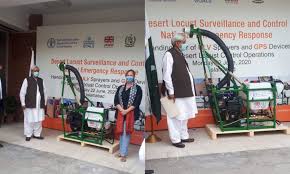ULV Sprayers and GPS devices handed over for effective surveillance and timely control operations of the desert locust

Islamabad: Swarms of Desert Locust can be of millions, fly up to 150 kilometers per day, and may travel nearly 2,000 kilometers in their lifetime to find a favorable environment for breeding. They rapidly reproduce and eggs usually hatch after about two weeks. Desert Locust, if not controlled, can generate a food security crisis or famine.
These insects grow and multiply under favorable agro-ecological conditions, mostly in desert areas, and after consuming the vegetation in one area, they migrate to other regions where food is available for them, creating a threat to food security and nutrition. East Africa and South West Africa are today fighting and making coordinated efforts against a Desert Locust invasionunprecedented in the last 25 years.
As part of the technical assistance to support the Government of Pakistan in its efforts to tackle the outbreak of desert locust in the country, the Food and Agriculture Organization of the United Nations (FAO) handed over 20 Ultra Low Volume (ULV) pesticides micron sprayers for vehicles, 1303 Personal Protection Equipment (PPE) and 100 Global Positioning System (GPS) satellite communicator devices to the Ministry of National Food Security & Research. Another 30 ULV sprayers are in the pipeline and will be delivered later this summer.
The procurement of the sprayers for pesticide and protective gear, funded by the Government of United Kingdom through its Department for International Development (DFID), and the GPS devices, procured by FAO through its core funding, aims to boost desert locust surveillance and control efforts of the Government of Pakistan and protect livelihoods and food security of millions of small holder farmers across the countrywho are already affected by the COVID-19 pandemic.
This upgraded equipment for control operations and new technology for surveillance will contribute to scaling up ground surveillance and control operations that are currently underway to curb the largest desert locust infestation in 25 years in the country.
The sprayers will allow to gear up control operations in the multiple and vast desert areas under threat to contrast in particular the expected next phase of Desert Locust threatfollowing the Monsoons. The PPE will ensure the full safety of the teams delivering control operations on the ground. Finally, the GPS devices configured with the eLocust3g application is an important innovation that, together with the eLocust3m application for mobile phones, will allow to expand, and improve in quality the coverage of surveillance data and interoperability amongst the Provinces and at Federal level, including in the many locust prone areas not covered by telecom network in Pakistan.
“Desert Locusts are a huge challenge as the swarms can destroy thousands of acres of vegetation. This equipment will help us maximize our efforts in confronting the locust threat. A coordinated and synergized effort is required to help our government confront this challenge,” said Fakhar Imam, Federal Minister of National Food Security & Research.
Dr Christian Turner: British High Commissioner to Pakistan, spoke at a ceremony to hand over the sprayers to the Pakistan Government today. He said: “Make no mistake, this locust outbreak is a big challenge. That is why the UK, through aid to FAO, has worked to ensure these UK-manufactured crop sprayers get to Pakistan as soon as possible.”
“FAO has been actively supporting the Ministry in leading the response to the Desert Locust threat since last year. Today we see the results of this excellent partnership, also thanks to thetimely financial support from DFID.
This equipment will help the Ministry and NLCC achieve more effective surveillance and control at the required scale.Improved surveillance information will help NLCC and Ministry make the best strategic decisions regarding the direction and prioritization of control operations day by day, and the additional sprayers will ensure capacity to carry these out. The surveillance monitoring of areas with little or no connection will help strengthen coordination with and among Provinces, and ensure control operations are directed timely in the most critical areas. This will avoid the risk of seeing the formation and migration of Locusts swarms to cropping areas and further negative impacts on food security, in particular for vulnerable communities that have already suffered from drought, floods or cold in the past months, and now COVID-19,” said MinàDowlatchahi, FAO Representative in Pakistan.
In a report released earlier this year, FAO had termed the current locust upsurge a threat to livelihoods and food security and nutrition of the vulnerable communities and populations of Pakistan and stated that ‘it is imperative to contain and control successfully the Desert Locust infestation.’
FAO is working in close collaboration with the National Ministry of Food Security and Research, Departments of the Plant Protection, the National Disaster Management Authority (NDMA) and the Provincial Disaster Management Authorities (PDMAs) to build capacities of the relevant government departments and local farming communities living in locust-prone and affected areas.





